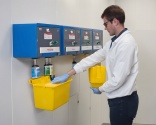Home › magazine › special features › Chemical dispensing systems the pros and cons
Chemical dispensing systems - the pros and cons
17th of June 2024How can chemical dispensing systems help companies to work more productively while also cutting costs and benefiting the environment? And do such systems have any downsides? ECJ asks companies their views.
THERE IS A GROWING TENDENCY for firms to use chemical dosing systems when carrying out cleaning procedures rather than having to dilute their products by hand. The traditional ‘glug glug’ method of mixing is now generally regarded as being old-fashioned, inaccurate and potentially unsafe. But what boxes do chemical dispensing systems actually tick? And as businesses strive to be more sustainable, efficient and cost-effective, how far do dosing systems help them to fulfil these ambitions?
Accurate dosing is a constant challenge and a time-consuming aspect of cleaning, says Kärcher’s accessories and detergents product manager Ilona Klein. “A dispensing system improves time efficiency while also preventing uneconomic overdosing,” she said. “Not only do these systems offer advantages from an economic and ecological viewpoint, they also ensure a consistent result without negative effects such as a sticky floor caused by overdosing.”
The wrong dosage will result in wasted cleaning agent while also potentially damaging surfaces, she said. “A dosing system will provide the right dilution ratio, reducing waste and preventing unnecessary expense,” said Klein. “It will also ensure that the correct dosage is used, even when applied by untrained personnel in a high staff-turnover situation. And users will benefit from the safe and ergonomic handling of the products.”
Trigger reactions
Concentrated chemicals used in professional cleaning can often be highly alkaline or acidic, she said. “If the recommended safety equipment such as gloves and goggles is worn incorrectly, substances in these products could trigger reactions if they should come into contact with the user’s skin or eyes,” she said. “Consequently, any contact with concentrated cleaning agents should ideally be reduced as far as possible. So a dosing system can make a valuable contribution to the cleaner’s occupational safety.”
When dosing systems in Kärcher’s scrubber dryers are combined with the company’s Eco!flow system they provide a uniform cleaning result, says Kärcher’s scrubber dryer application expert Patrick Prasser. “This significantly reduces the consumption of water and cleaning agent because the quantity is adjusted every time the operator slows down for bends and obstacles,” he said.
Even less contact
Dosing systems in the future are likely to require even less direct contact with the detergent concentrate, Prasser predicts. “They may also include individualised connection systems and digital networking options,” he adds. “The inclusion of digital features might thereby provide additional support in terms of centralised data availability and resource planning.
“In fact, we have already implemented an app connection into our B 50 W scrubber dryer that makes managing authorisations and setting up dilution levels even more intuitive.”
Automatic dosing prevents the glugging and spillages often associated with manual dispensing, says Fenton Packaging Solutions’ supply chain managing partner David Wilson. “The fact that the product is usually housed in a secure container means there is an immediate health and safety benefit,” he said.
“Chemical dispensing equipment also provides an accurate dosage each time provided the equipment is calibrated regularly and the system is maintained. And this delivers cost control benefits and takes out all the guesswork.”
Dosing systems allow chemical manufacturers to supply their product in concentrated form, he says. “This in turn means they can specify a more sustainable pack size by supplying a 10-litre bag-in-box concentrated pack, for example, rather than a 20-litre or 25-litre rigid plastic pack that contains a chemical and water mix,” he said.
“Smaller packs allow for easier storage while the reduced weight involved improves moving and handling. And another advantage is that a bag-in-box pack can be safely connected to the dosing system hardware using snap-on connectors which minimises the risk of spillage.”
Such systems can be set to produce cleaning product at the point of installation – which is the ultimate goal, he adds. “While minor tweaks may be needed, a subsequent call by the installer every four to six weeks to check the dosage is all that will be required,” he said. “With conventional pouring there is no consumption control, and this can lead to rising costs.”
Safer than manual
Dispensing systems are safer than manual dosing because they prevent any contact between the chemicals and the user, according to Wilson. They also allow businesses to easily gather usage data, he says. “Another advantage is that a controlled system eliminates the risk of theft, whereas traditional jerrycans and 750 ml trigger bottles can easily go missing,” he adds.
“Dispensing systems have also moved on enormously which means that all information is now at the users’ fingertips and they can quickly identify and rectify any areas of concern.”
As sustainability moves further up companies’ agendas there are an increasing number of environmentally-friendly solutions entering the market, he says. “For example, the box used in our Cheertainer bag-in-box can be separated from the liner after use and the box can then be recycled, while the liner can be used in the waste-to-energy arena,” he said.
The Cheertainer system can be used to dispense a variety of substances and is claimed to deliver 99.8 per cent of the product from within the bag, says Wilson.
Chemical dispensing systems ease the cleaning burden and make the whole process more efficient, according to Greenspeed marketing executive Rosaliene Verhoef. “They measure out the exact amount of chemical required on the spot, making manual mixing a thing of the past,” she said. “This guarantees consistent cleaning results without the hassle.
“Dispensing systems also keep a tight grip on how much chemical is being used, which prevents overdosing and avoids situations such as method errors, residue build-ups and unnecessary costs. And by using concentrated chemicals, companies can minimise their waste and lower their carbon footprint.”
She says dispensing systems that prevent any contact between the customer and the chemicals are safer than manual dosing methods. “Such systems reduce the risks of accidents or mishandling and underscore the company’s commitment to ensuring a safe workplace environment,” she said.
Reduce risk
“Accurate dosing also ensures an effective clean and prevents issues such as sticky surfaces. These systems further enhance efficiency by delivering high-performance cleaning specifically formulated for different water hardness levels. And they enable companies to collect valuable data on chemical usage, providing the insights they need to fine-tune their processes and make informed decisions.”
Greenspeed’s Bag-in-Box systems are said to significantly reduce cleaners’ direct exposure to potentially hazardous substances and provide a safe and user-friendly experience. The company also offers Probio Tabs which are probiotic effervescent tablets designed to be added to water.
Chemical dispensing systems can speed up operations, cut costs and produce safer results, says Brightwell’s product manager Tom Ford. “Safety is paramount so a closed system will minimise exposure to harmful chemicals both for employees and for end-users,” he said.
Precise dosing
“Chemicals are formulated to clean surfaces at a specified dilution rate which means both under-dosing and over-dosing can have negative consequences. Using too much chemical is wasteful and will increase operational costs, while also leaving behind residues that are difficult
to rinse off. However, failing to use sufficient chemical concentrate will compromise cleanliness and could lead to customer dissatisfaction. So precise dosing will save resources and promote environmental responsibility.”
Dosing systems that prevent any end-user contact with the chemicals typically offer safety advantages over manual dosing methods, he says. “However, thoughtfully-designed manual dosing solutions can still be a safe option when they enable precise dosage at specific ratios or provide secure containers for chemicals,” he said.
Besides enhancing cleaning and hygiene efficiency, dosing systems also offer sustainability benefits, says Ford. “Using highly concentrated chemicals at proper doses ensures efficient cleaning while also reducing shipping requirements, packaging and waste,” he said. “Other important advantages include access to valuable data reporting such as chemical usage reports, since these help to ensure that all cleaning processes are managed smoothly, efficiently and cost-effectively.”
Brightwell’s EcoSprayer and EcoFoamer systems are designed for heavy-duty cleaning and for disinfecting large areas. These systems are said to automatically dilute and dispense a controlled dosage of product without the user coming into contact with the chemical during the dilution process.
According to Ford, customers are increasingly demanding connectivity in their products. “They are seeking the ability to remotely access pumping systems in order to enable real time reporting,” he said.
“The technology we’re developing will ultimately span the range of products we produce and this will enable greater efficiency and effectiveness in our customers’ businesses and also benefit their own carbon footprint.”
So, are there any arguments against using a dosing system? “It has to be fit for purpose,” says Fenton Packaging’s David Wilson. “Dispensing systems come at a cost which means the supplier has to recoup that cost. So it is important to ensure that the usage matches the investment.”
Brightwell’s Tom Ford believes manual dosing can be more appropriate than chemical dispensing in certain situations. “Manual dosing allows for a hands-on approach, particularly in scenarios where it is important to allow on-site manual management and where cost considerations are paramount,” he says.
Kärcher’s Patrick Prasser says the installation costs of dosing systems can be off-putting for some. “However, this is offset by the savings made from avoiding overdosing along with the increased safety of employees,” he said.
In some environments the cleaning solution needs to be prepared on site, he adds. “If a two-bucket method is employed in a larger location such as an airport and the cleaning agent runs out, the nearest supply room might not be around the corner,” he said. “And in some cases a permanent installation is impractical. So in these situations we might recommend the use of a dosing head that is screwed directly on to the bottle, or a machine with a built-in dosing system.”
Greenspeed’s Rosaliene Verhoef agrees that the initial investment can be an argument against installing a dispensing system. “There is also a need for proper training so that staff are equipped with the know-how to effectively use these systems,” she says. “Technical maintenance is another factor since regular upkeep of dosing systems is essential for optimal performance.
“However, we feel the long-term advantages and efficiency benefits outweigh these concerns and
that the convenience, safety and sustainability of dosing systems often prove to be much more significant in the grand scheme of things.”









